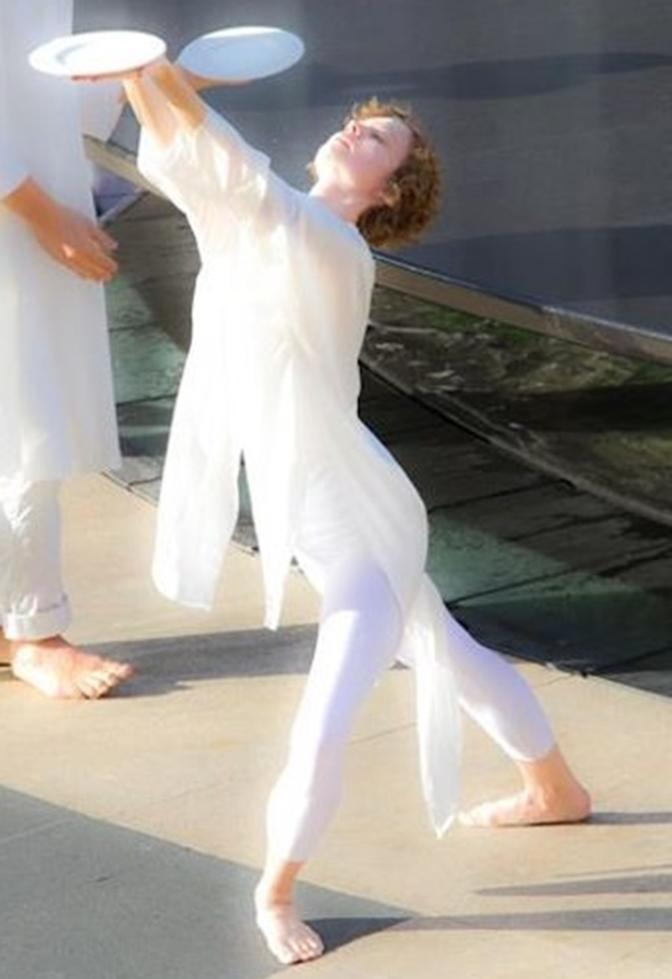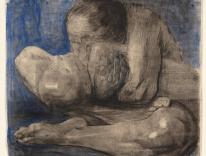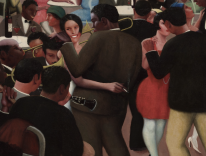A man walks slowly onto the shimmering stone plaza and lifts a pink conch shell to his mouth. A low note sounds, rising and falling with pauses like a gasp for breath between sobs. It is both a cry and a call to gather: more than a hundred dancers dressed in white rush onto the plaza, circling the musician like a hurricane.
This is the beginning of Buglisi Dance Theatre’s The Table of Silence Project 9/11, which was created for the tenth anniversary of the September 11 attacks and has been performed annually ever since. The dance is part commemoration, part meditation, and part call to action. Set in motion by the summoning conch—an instrument considered sacred in Hinduism, Buddhism, and other traditions—the dance becomes a choreographed requiem, an embodied liturgy.
The Table of Silence Project 9/11 is a site-specific work made for the Josie Robertson Plaza at Lincoln Center in Manhattan—the space bounded by the Metropolitan Opera, the Koch Theatre, and David Geffen Hall—which looks like a giant spiderweb with a fountain in the middle.
Award-winning choreographer Jacqulyn Buglisi, who was a celebrated member of the Martha Graham Dance Company for many years, says the project “creates an opportunity to commemorate the loss of life and the bravery of all those affected by 9/11. At the same time, it will celebrate our determination and the strength of our belief in freedom for all humanity.” She refers to her ensemble as “peace warriors” who are professional and recreational artists from all over New York City, including members of the Martha Graham and Alvin Ailey American Modern Dance companies and Juilliard students. The project is performed for a live audience and reaches thousands of viewers all over the world through its livestream.
As that initial call of the conch subsides, the dancers break out of the cyclone, line up on opposite sides of the plaza, and march forward in procession to the sound of a bass drum. As they reenter the plaza, they repeat a series of twelve solemn gestures, each performed ten times.

In one gesture, the dancers bow their heads and move their pinched fingers up and down as if pulling a needle and thread. In another, they extend their arms and pound the air with their fists. Some motions plead—clasped palms press down then up, over and over—while others contemplate—restless hands tap together while heads bow in thought. Each is a prayer.
The gestures culminate in a moment of song: Prefaced by a fluttering of their hands on their chests, the dancers gaze up toward the sky and release a note. The sound grows and is topped off by a higher, operatic pitch that resounds from an ensemble of vocalists dispersed throughout the space. (Later, these vocalists will have their own moment when, for several minutes, the dancers are still. The vocalists call and respond to each other across the plaza, and the sound bounces between the ground and the surrounding walls. The songs become ghost-like, untraceable echoes.)
Following the pattern of the plaza, the dancers often end up in three large concentric circles. Each circle of movement turns in the opposite direction of the circle before it to the beat of the bass drum, the ensemble creating a bird's-eye view of gears shifting inside a clock.
Keeping time is an essential theme of the work, both in terms of rhythm and in terms of dates and hours. The event takes place every year on the morning of September 11 to mark the moment when the first tower fell. The frantic entrance of the dancers, whose bodies and white costumes are painted with pale, ashy makeup, creates an environment of chaos. Shaking and clasped hands depict confusion and devastation. The Table of Silence is a transportive work, and it brings us first to the memory of 9/11 itself.
As the piece continues, the horror and sorrow become meditations, song, and collective action. Grief is not replaced but transformed as we in the audience lose track of where we are, what's going on, and what time it is now.
Suddenly, the dancers walk up to one another and reveal a surprise. A porcelain plate, designed by the Italian artist Rossella Vasta, has been tucked away in each person’s costume. For the remainder of the piece, the dancers hold onto their plates, always with two hands. They press them to their hearts. They lift them up to the sky. They sit, and the plates rest in their laps. They prepare for communion.
Communion is central to The Table of Silence. From the beginning, there is an emphasis on community: after rushing around the plaza, the “peace warriors” freeze sporadically in tableaux. Some tumble to the ground while others stand in extended lunges with arms outstretched, reaching toward the fallen. There is a sense of brotherhood, and the repeated use of ensemble unison ensures that the piece can only be realized as a collective pursuit.
Now, with the plates uncovered, the ensemble gathers for yet another communal experience. The delicate, pale, round pieces sparkle in the sunlight like visions of the Host.
Although the entirety of the piece occurs with minimal musical accompaniment, it is not actually silent until the end. Seated cross-legged, the hundred dancers open their arms from their chests and throw their heads up to the clouds in a choreography that resembles the blossoming of an extraordinary white rose.
For several minutes, the dancers just sit there, still and quiet. In the silence, the audience is jolted into an awareness of just how vast the space is that the dancers occupy. Upon first glance, we might have thought of the space only as the fountain in the center of the plaza. Little by little, we begin to notice the expanse of the plaza, aided by the dancers’ traces of its orbiting rings. Finally, at the end, following the trajectory of the hundreds of eyes piercing through the sky, the audience encounters all of that space that was above us, too, endless and inviting.
What was the Josie Robertson Plaza is now a sacred space, transcending the walls and streets which seemed to be its limits and taking us along with it.
This is a revelation that happens in a fleeting instant. Soon, the bass drum reenters the soundscape, and the dancers rise to its pulse. They turn and close their feet together, the precious plates held tightly against their breasts. They exit, and The Table of Silence ends.
The whole piece lasts under an hour. When the plaza is cleared, we see it again within its borders: the empty, webbed space fenced in by the three towering theaters.
What a striking contrast: just a few minutes before, hundreds of bodies were unified together in memory and in movement. In the words of William Blake, “the doors of perception were cleansed,” and everything appeared “as it is: infinite.”
Please email comments to [email protected] and join the conversation on our Facebook page.
Previous Story
Waist Deep in the Big Muddy
Next Story
Developing the Voice of the Laity


